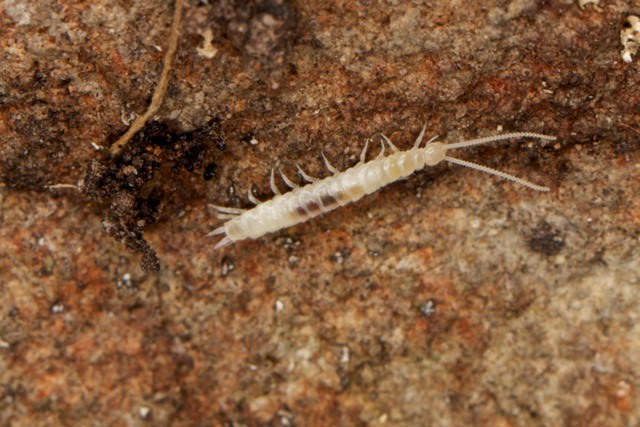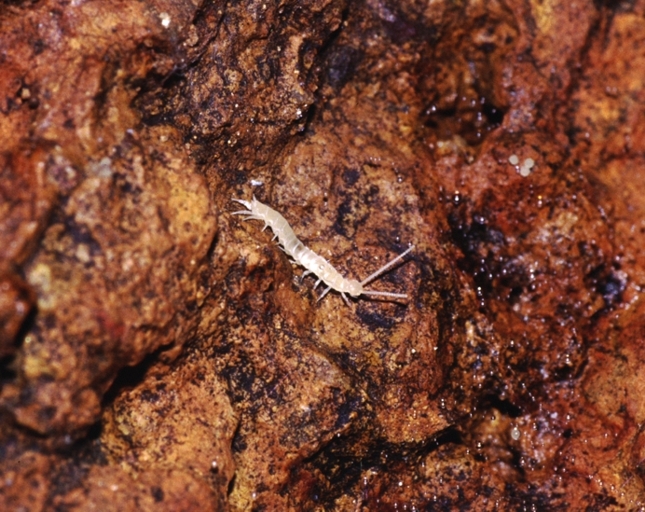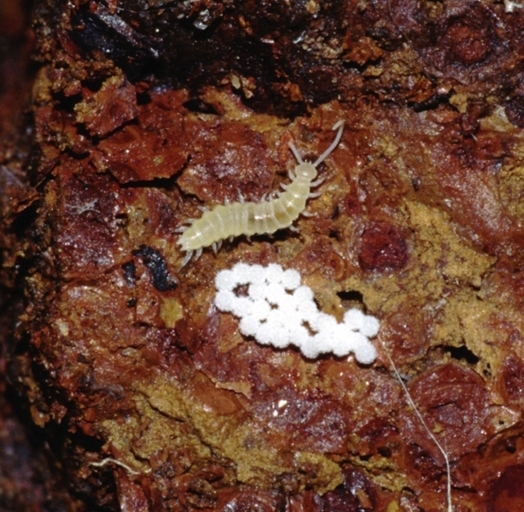Phylum Arthropoda
Subphylum Myriapoda
Class Symphyla
Common names: symphylans, garden centipedes, glasshouse symphylans
Overview
Symphylans are small soil-dwelling myriapods that resemble centipedes, but are smaller and translucent. They can move rapidly through the spaces between soil particles, and are typically found from the surface down to a depth of about 50 cm. The body is soft and without pigment. Symphylans range from 2-30 millimetres long and have two body regions: a head and segmented trunk. The head has long, segmented antennae, a postantennal organ and three pairs of mouth-parts: mandibles, long first maxillae and a second pair of maxillae fused to form the lower lip or labium of the mouth. The trunk consists of 12 leg-bearing segments covered by 15-24 tergites, which allow extraordinary body flexure and rapid movement through the soil. At the base of each leg is a short stiff spine and special sac. The spine helps the symphylan move through the soil, while the sac regulates water and salts in the body. The posterior-most appendages are a pair of cerci that possess silk glands and long sensory structures termed trichobothria or sensory calicles. Juveniles have six pairs of legs, but, over a lifetime of several years, add an additional pair at each moult. They are often an important component of the soil/litter fauna, and can number in the thousands per square metre.
Distribution and diversity
The symphlans occur worldwide, predominantly in the tropics. The group is poorly described with about 160 species known worldwide, traditionally classified into the families Scutigerellidae and Scolopendrellidae. There are currently 29 species in Australian in six genera, however there are many undescribed taxa and the true size of the Australian fauna has been estimated at 150 species.
Life cycle
Males deposit sperm packets on top of short stalks of silk on the ground. The females pick up the sperm packets in their mouths. Most are swallowed and digested, but some are stored in special sacs in her mouth. She removes each egg from her reproductive organs and fertilizes them in her mouth. Females deposit 4 to 25 pearly-white eggs in a mass at various depths in the soil depending on soil temperature, moisture, and structure. Eggs hatch in about 40 days and nymphs begin feeding on small roots. Symphylans have incomplete metamorphosis and develop through six growth stages, or instars. The hatchlings have fewer body segments than adults and only six or seven pairs of legs. With each molt they add an additional segment and pair of legs until they reach adulthood with twelve pairs. Growth from egg to adult requires about six to nine weeks, allowing for several generations each year. Symphylans usually live six to 12 months, but some may live four years or more.
Feeding
Symphylans are herbivores and detritus feeders that feed primarily on fungi and decaying plant material in soil, thereby helping to make nutrients available for new plant growth. A few symphylans feed on living plants, including a species of Hanseniella that has been recorded as a pest of sugar cane and pineapples in Queensland. The garden centipede, Scutigerella immaculata, will eat seeds, seedlings and fine roots, and can be a serious pest of vegetable crops and tree seedlings in greenhouses as well as agricultural situations. One species of Symphylella has been shown to be predominately predacious, but most species are probably omnivorous, feeding on both plant and animal materials.
Ecology
Symphyla are small, blind, fast-running myriapods which can be very abundant in soil and forest litter. They live deep in the soil, under stones, in decaying wood, under bark and in other moist microhabitats. They are often found in large numbers and sometimes gather in groups. They move up and down in the soil to maintain the proper moisture levels in their surroundings. Their antennae move constantly as they move about searching for food and mates, but they are held back over the body when feeding. Symphylans live in the upper layers of soil in both natural and agricultural habitats, but migrate deeper below ground when the surface freezes or if conditions are hot or dry.
A few species are found up trees and in caves, including the largest recorded symphylan (25-30 mm), Hanseniella magna, described from two Tasmanian caves. It has true troglobitic morphology with exceptionally elongate antennae, claws and cerci. Although symphylans have some morphological features that are advantageous to subterranean habitats, such as depigmentation, blindness and long antennae, most species that have been found in caves are epigean and ill-adapted for cave life.
No symphyla are considered endangered or threatened. However, symphylans are not very well known, and it is possible that species exhibiting short-range endemism could be vulnerable to extinction if their habitats were spoiled or destroyed.

Symphylan found amongst leaf litter under rocks, Tasmania
Image credit:
� Kristi Ellingsen used with permission.

Symphylan from Western Australia
Image credit: Photographer: Erich S. Volschenk
� Western Australian Museum

Symphylan from Western Australia, guarding eggs
Image credit: Photographer: Erich S. Volschenk
� Western Australian Museum









